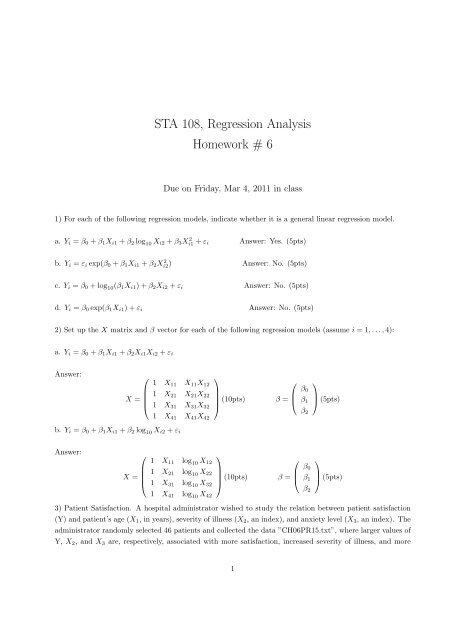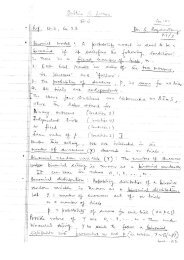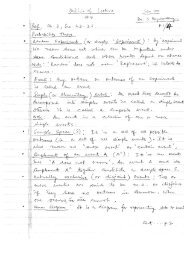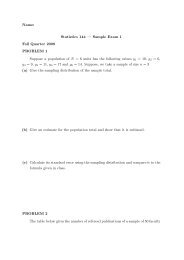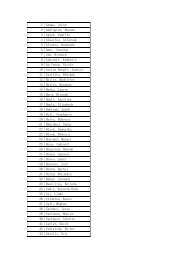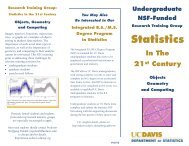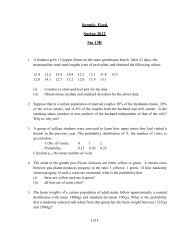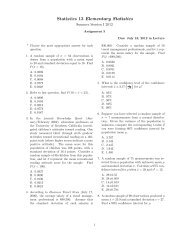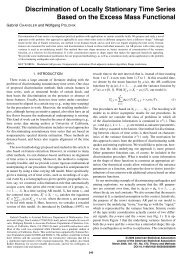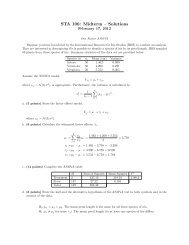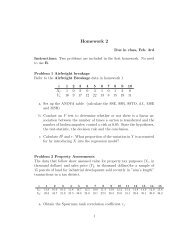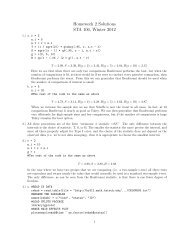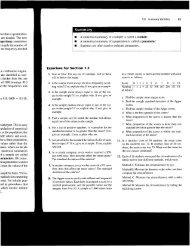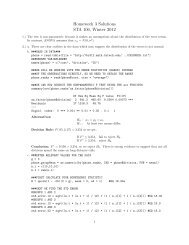STA 108, Regression Analysis Homework # 6
STA 108, Regression Analysis Homework # 6
STA 108, Regression Analysis Homework # 6
Create successful ePaper yourself
Turn your PDF publications into a flip-book with our unique Google optimized e-Paper software.
<strong>STA</strong> <strong>108</strong>, <strong>Regression</strong> <strong>Analysis</strong><br />
<strong>Homework</strong> # 6<br />
Due on Friday, Mar 4, 2011 in class<br />
1) For each of the following regression models, indicate whether it is a general linear regression model.<br />
a. Yi = β0 + β1Xi1 + β2 log 10 Xi2 + β3X 2 i1<br />
+ εi<br />
Answer:<br />
Yes. (5pts)<br />
b. Yi = εi exp(β0 + β1Xi1 + β2X 2 i2 ) Answer: No. (5pts)<br />
c. Yi = β0 + log 10(β1Xi1) + β2Xi2 + εi<br />
d. Yi = β0 exp(β1Xi1) + εi<br />
Answer: No. (5pts)<br />
Answer: No. (5pts)<br />
2) Set up the X matrix and β vector for each of the following regression models (assume i = 1, . . . , 4):<br />
a. Yi = β0 + β1Xi1 + β2Xi1Xi2 + εi<br />
Answer:<br />
⎛<br />
⎜<br />
X = ⎜<br />
⎝<br />
b. Yi = β0 + β1Xi1 + β2 log 10 Xi2 + εi<br />
Answer:<br />
⎛<br />
⎜<br />
X = ⎜<br />
⎝<br />
1 X11 X11X12<br />
1 X21 X21X22<br />
1 X31 X31X32<br />
1 X41 X41X42<br />
1 X11 log 10 X12<br />
1 X21 log 10 X22<br />
1 X31 log 10 X32<br />
1 X41 log 10 X42<br />
⎞<br />
⎛<br />
⎟<br />
⎜<br />
⎟ (10pts) β = ⎝<br />
⎠<br />
⎞<br />
⎛<br />
⎟<br />
⎜<br />
⎟ (10pts) β = ⎝<br />
⎠<br />
β0<br />
β1<br />
β2<br />
β0<br />
β1<br />
β2<br />
⎞<br />
⎟<br />
⎠ (5pts)<br />
⎞<br />
⎟<br />
⎠ (5pts)<br />
3) Patient Satisfaction. A hospital administrator wished to study the relation between patient satisfaction<br />
(Y) and patient’s age (X1, in years), severity of illness (X2, an index), and anxiety level (X3, an index). The<br />
administrator randomly selected 46 patients and collected the data ”CH06PR15.txt”, where larger values of<br />
Y, X2, and X3 are, respectively, associated with more satisfaction, increased severity of illness, and more<br />
1
anxiety.<br />
a. Fit regression model for three predictor variables to the data and state the estimated regression function.<br />
How is b2 interpreted here?<br />
Answer: The estimated regression function is ˆ Y = 158.4913 − 1.1416X1 − 0.4420X2 − 13.4702X3 (10pts)<br />
b2 is an estimate of the change in the mean response per unit increase in X2 when X1 and X3 are held<br />
constant. (10pts)<br />
b. Plot the residuals against ˆ Y , and each of the predictor variables on separate graphs(20pts). Interpret<br />
your plots and summarize your findings (10pts).<br />
residuals<br />
residuals<br />
−15 −5 0 5 10<br />
−15 −5 0 5 10<br />
(a)Residual Plot against Fitted Value<br />
40 50 60 70 80 90<br />
fitted values<br />
(c)Residual Plot against X2<br />
45 50 55 60<br />
severity of illness<br />
residuals<br />
residuals<br />
−15 −5 0 5 10<br />
−15 −5 0 5 10<br />
Figure 1: residual plot<br />
(b)Residual Plot against X1<br />
25 30 35 40 45 50 55<br />
patient’s age<br />
(d)Residual Plot against X3<br />
1.8 2.0 2.2 2.4 2.6 2.8<br />
anxiety level<br />
Plot(a) is the residual e against the fitted values ˆ Y , it does not suggest any systematic deviations from the<br />
response plane, nor that the variance of the error terms varies with the level of ˆ Y . Plots of the residuals e<br />
against X1 and X2 in (b), (c) and (d), are entirely consistent with the conclusions of good fit by the response<br />
function and constant variance of the error terms.(10pts)<br />
2


